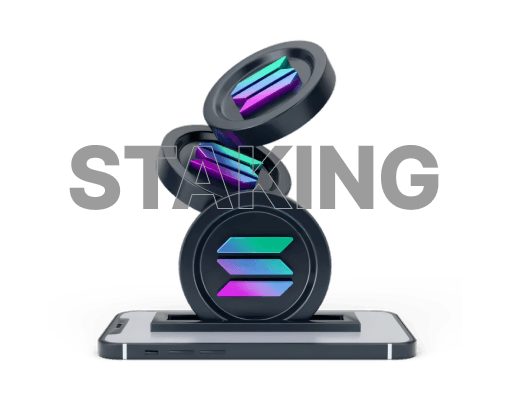Staking Solana:
A Step-by-Step Guide to Earning Passive Rewards

Time to read: 10 min
Solana is a prominent blockchain celebrated for its high transaction speeds and low fees. Beyond its technical capabilities, Solana offers an enticing opportunity for crypto enthusiasts: staking. By staking your SOL tokens, you actively contribute to the network's security and, in return, earn passive income. This guide explains the essentials of staking on Solana, showing you how to put your assets to work.
How to Stake Solana and Earn Passive Income
Staking SOL offers more benefits than simply holding the tokens. At its core, staking involves locking up your SOL to support network operations, a process far more accessible than hardware-intensive mining. It unlocks the potential for passive income, allowing you to increase your holdings without actively trading. By staking, you also play a direct role in maintaining the health and security of the Solana network.
Furthermore, staking rewards can help offset the effects of network inflation, which can otherwise decrease the value of your assets over time. During periods of market volatility, staking provides a steady stream of rewards, offering a buffer against price fluctuations and helping you accumulate more SOL.
What is Solana Staking? Understanding the Basics
To understand staking, it helps to know how the Solana network operates. Solana uses a unique combination of Proof-of-Stake (PoS) and Proof-of-History (PoH) to achieve high transaction speeds and scalability. When you stake your SOL, you delegate them to validators who verify transactions and secure the network. This collective effort maintains Solana's integrity, and participants earn rewards for their contribution.
The integration of PoH is what sets Solana apart. PoH creates a verifiable, cryptographic timestamp for each transaction, which streamlines the PoS consensus process. This dual model enables Solana to process thousands of transactions per second efficiently and securely. Because this method is less energy-intensive than traditional Proof-of-Work (PoW) networks, Solana is also a more environmentally friendly option.
The Role of a Staking Account
A staking account is a crucial component of this process. It is a specialized account designed specifically to hold your staked SOL tokens. When you delegate SOL to a validator, your tokens are transferred into this account, which tracks how much you've delegated, your chosen validator, and the rewards you've earned. Unlike a regular wallet account that holds liquid tokens for transactions, a staking account locks your funds in place. While you always retain ownership, the tokens are 'bonded' to the validator until you choose to undelegate them.
Creating a Staking Account
Getting started with Solana staking is straightforward. Follow these steps to begin earning rewards:
- First, select a platform or wallet that supports Solana staking. Popular self-custody wallets like Phantom and Solflare provide user-friendly interfaces, while hardware wallets like Ledger offer enhanced security. Alternatively, some centralized exchanges offer staking services, though using a personal wallet provides more control.
- Next, acquire SOL tokens from an exchange and transfer them into your wallet if you do not already have them.
- Research and choose a reliable validator. Consider their performance history, uptime, and commission fees, as this will directly affect your earnings.
- Using your wallet's staking interface, delegate your SOL to the chosen validator. This process will create a dedicated staking account for you.
- Finally, monitor your staking rewards through your wallet. Your earnings will compound automatically over time, increasing your total SOL holdings.
Maximizing Your Returns and Staying Secure
Best Practices for Staking
To maximize your returns and minimize risk, choose your validator carefully. Look for validators with a strong performance history and a competitive commission rate. Staking is not a 'set-it-and-forget-it' activity. Periodically monitor your validator's performance; if it declines, you can easily redelegate your stake to a different validator through your wallet. Also, be aware of the unstaking period. When you decide to withdraw your SOL, it may take an entire epoch (typically 2-3 days) before your tokens become accessible.
Understanding Rewards, Fees, and Inflation
Staking rewards are influenced by the total amount of SOL staked on the network and your validator's performance. Validators charge a commission fee for their services, which is deducted from your rewards. Additionally, Solana has a planned inflation schedule that introduces new SOL into circulation. Staking rewards are designed to counteract this inflation, helping your holdings grow over time. Staking is a long-term strategy where the power of compounding returns can lead to substantial growth.
Conclusion
Staking on Solana provides a powerful way to earn rewards while contributing to the network's security. By choosing a reliable validator, understanding the fee structure, and adopting a long-term perspective, you can effectively grow your SOL holdings. With its user-friendly wallets and efficient network, Solana makes it simple for anyone to become an active participant in its growing ecosystem.
FAQ
Similar guides
Is Solana a Good Investment?
Expert Analysis
Oct 28, 2025
Solana Price History:
Understanding the Highs and Lows
Sep 19, 2025
Solana (SOL):
Revolutionizing Blockchain Technology
Sep 24, 2025

Solana is a prominent blockchain celebrated for its high transaction speeds and low fees. Beyond its technical capabilities, Solana offers an enticing opportunity for crypto enthusiasts: staking. By staking your SOL tokens, you actively contribute to the network's security and, in return, earn passive income. This guide explains the essentials of staking on Solana, showing you how to put your assets to work.
How to Stake Solana and Earn Passive Income
Staking SOL offers more benefits than simply holding the tokens. At its core, staking involves locking up your SOL to support network operations, a process far more accessible than hardware-intensive mining. It unlocks the potential for passive income, allowing you to increase your holdings without actively trading. By staking, you also play a direct role in maintaining the health and security of the Solana network.
Furthermore, staking rewards can help offset the effects of network inflation, which can otherwise decrease the value of your assets over time. During periods of market volatility, staking provides a steady stream of rewards, offering a buffer against price fluctuations and helping you accumulate more SOL.
What is Solana Staking? Understanding the Basics
To understand staking, it helps to know how the Solana network operates. Solana uses a unique combination of Proof-of-Stake (PoS) and Proof-of-History (PoH) to achieve high transaction speeds and scalability. When you stake your SOL, you delegate them to validators who verify transactions and secure the network. This collective effort maintains Solana's integrity, and participants earn rewards for their contribution.
The integration of PoH is what sets Solana apart. PoH creates a verifiable, cryptographic timestamp for each transaction, which streamlines the PoS consensus process. This dual model enables Solana to process thousands of transactions per second efficiently and securely. Because this method is less energy-intensive than traditional Proof-of-Work (PoW) networks, Solana is also a more environmentally friendly option.
The Role of a Staking Account
A staking account is a crucial component of this process. It is a specialized account designed specifically to hold your staked SOL tokens. When you delegate SOL to a validator, your tokens are transferred into this account, which tracks how much you've delegated, your chosen validator, and the rewards you've earned. Unlike a regular wallet account that holds liquid tokens for transactions, a staking account locks your funds in place. While you always retain ownership, the tokens are 'bonded' to the validator until you choose to undelegate them.
Creating a Staking Account
Getting started with Solana staking is straightforward. Follow these steps to begin earning rewards:
- First, select a platform or wallet that supports Solana staking. Popular self-custody wallets like Phantom and Solflare provide user-friendly interfaces, while hardware wallets like Ledger offer enhanced security. Alternatively, some centralized exchanges offer staking services, though using a personal wallet provides more control.
- Next, acquire SOL tokens from an exchange and transfer them into your wallet if you do not already have them.
- Research and choose a reliable validator. Consider their performance history, uptime, and commission fees, as this will directly affect your earnings.
- Using your wallet's staking interface, delegate your SOL to the chosen validator. This process will create a dedicated staking account for you.
- Finally, monitor your staking rewards through your wallet. Your earnings will compound automatically over time, increasing your total SOL holdings.
Maximizing Your Returns and Staying Secure
Best Practices for Staking
To maximize your returns and minimize risk, choose your validator carefully. Look for validators with a strong performance history and a competitive commission rate. Staking is not a 'set-it-and-forget-it' activity. Periodically monitor your validator's performance; if it declines, you can easily redelegate your stake to a different validator through your wallet. Also, be aware of the unstaking period. When you decide to withdraw your SOL, it may take an entire epoch (typically 2-3 days) before your tokens become accessible.
Understanding Rewards, Fees, and Inflation
Staking rewards are influenced by the total amount of SOL staked on the network and your validator's performance. Validators charge a commission fee for their services, which is deducted from your rewards. Additionally, Solana has a planned inflation schedule that introduces new SOL into circulation. Staking rewards are designed to counteract this inflation, helping your holdings grow over time. Staking is a long-term strategy where the power of compounding returns can lead to substantial growth.
Conclusion
Staking on Solana provides a powerful way to earn rewards while contributing to the network's security. By choosing a reliable validator, understanding the fee structure, and adopting a long-term perspective, you can effectively grow your SOL holdings. With its user-friendly wallets and efficient network, Solana makes it simple for anyone to become an active participant in its growing ecosystem.
